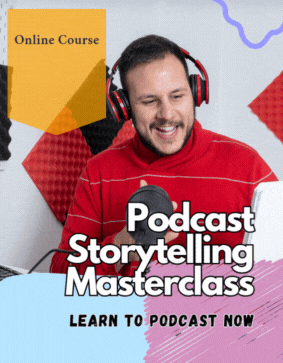5 things you need to create a podcast #podcast #podcasting
17,364 View
Share this Video
- Publish Date:
- June 11, 2025
- Category:
- Podcasting
- Video License
- Standard License
- Imported From:
- Youtube
Tags
5 things you need to create and setup a podcast
Microphone - A simple USB one will do the job perfectly.
Video camera - Add some visual appeal to your content.
Lighting - This will make your video look professional and appealing to engage with
Headphone - to monitor and adjust your sound quality.
Podcast recording software - This will determine the quality of your podcast and the time you spend on editing #podcast #podcasting
-----------------------------------------
Podcast Pacing for Audience Engagement
🎙️ Want to capture your listeners’ attention and keep them hooked? Podcast Pacing for Audience Engagement is your guide to mastering the rhythm of compelling communication. You'll learn how to build a strong pacing foundation, shift your pace to add value, understand how your delivery is perceived, and use pacing to express authentic passion. Whether you're just starting out or looking to fine-tune your skills, this class will help you speak with greater impact and confidence.
👉 Click here to join the online course now and start creating podcasts your audience will love!
3 Must-Know Podcasting Tips for Your Show
Crafting Compelling Podcast Introductions

Your podcast introduction sets the tone for each episode and captures the listener’s attention from the start. Begin with a brief and impactful summary of the episode’s topic to inform your audience about what to expect. Use a consistent musical theme or jingle to create brand recognition. Introduce yourself and any co-hosts clearly, establishing a personal connection with your listeners. Incorporate a hook, such as a provocative question or an interesting fact, to pique curiosity. A well-crafted introduction not only engages listeners but also reinforces your podcast’s identity and purpose, encouraging them to continue listening.
Analyzing Podcast Metrics to Improve Performance

Monitoring and analyzing podcast metrics is crucial for understanding your audience and improving your show’s performance. Track key indicators such as download numbers, listener demographics, episode completion rates, and audience retention. Use analytics tools provided by your hosting platform or third-party services to gain insights into listener behavior and preferences. Identify which episodes perform best and analyze the factors contributing to their success, such as topics, guests, or formats. Pay attention to feedback and reviews to gauge audience satisfaction and areas for improvement. Regularly reviewing your metrics allows you to make informed decisions, optimize your content strategy, and enhance the overall quality and reach of your podcast.
Building a Strong Podcast Brand Identity

A strong brand identity distinguishes your podcast in a crowded market and fosters loyalty among listeners. Define your podcast’s unique value proposition by identifying what sets it apart from others in the same genre. Develop a recognizable logo and consistent color scheme that reflects your podcast’s personality and theme. Craft a compelling tagline that succinctly conveys your podcast’s mission and appeal. Maintain consistency in your communication style, tone, and visual elements across all platforms, including your website and social media profiles. A cohesive brand identity not only attracts your target audience but also makes your podcast memorable and professional, encouraging long-term growth.
Frequently Asked Questions
What role do podcast covers and branding play?
Visual elements like podcast covers and branding are crucial for making a strong first impression, attracting potential listeners, and conveying the essence of your show effectively.
What are the best practices for podcast episode structure?
Start with a strong introduction, followed by the main discussion or interview, and end with a summary or call to action. Consistent formatting helps listeners know what to expect each episode.
What are effective ways to promote my podcast?
Utilize social media, collaborate with other podcasters, submit your show to podcast directories, and engage with your audience through newsletters or community forums to expand your reach.
What is the best way to prepare for a podcast interview?
Research your guest thoroughly, prepare insightful questions, test your equipment beforehand, and create a comfortable environment to facilitate a natural and engaging conversation.
How often should I release new podcast episodes?
Consistency is key. Whether weekly, bi-weekly, or monthly, establish a schedule that you can maintain to keep your audience engaged and coming back for more.
Statistics
- High audio quality can lead to a 35% increase in listener retention rates.
- Approximately 65% of podcasters monetize their shows through sponsorships and advertising.
- Approximately 40% of podcasters use background music to enhance the listening experience.
- On average, podcasters spend about 10 hours per episode from planning to publishing.
- Podcasts utilizing video snippets on social media experience a 20% rise in audience interaction.
- Podcasts with eye-catching cover art are 45% more likely to attract new listeners.
- Podcasts with consistent weekly releases are 60% more likely to grow their audience steadily.
- About 60% of podcasters find that offering premium content subscriptions generates additional revenue.
- Listener reviews and ratings contribute to a 25% increase in podcast discoverability.
- About 50% of podcast listeners prefer shows that offer a mix of solo and interview episodes.
- Using transcription services can make podcasts accessible to a wider audience, increasing reach by up to 25%.
- Over 80% of podcasters report that having a dedicated website enhances their show’s visibility.
- Podcasts with interactive segments, such as Q&A sessions, see a 25% boost in audience participation.
- Listeners are 50% more likely to subscribe to podcasts that offer regular episode releases.
- Effective use of keywords in podcast descriptions can improve search rankings by 30%.
- Guest appearances on podcasts can result in a 15% increase in subscriber numbers.
External Links
hootsuite.com
blog.podomatic.com
anchor.fm
buzzsprout.com
patreon.com
podbean.com
podcasters.spotify.com
thepodcasthost.com
jeffbullas.com
listennotes.com
transistor.fm
shutterstock.com
apple.com
blog.libsyn.com
ahrefs.com
optimizingpodcasting.com
podcastitalia.com
How To
How To Use Analytics to Understand Your Podcast Audience
Using analytics to understand your podcast audience provides insights into their preferences and behaviors, helping you tailor your content effectively. Begin by accessing your podcast hosting platform’s analytics dashboard, which typically offers data on downloads, listener demographics, geographic locations, and listening durations. Analyze this information to identify trends, such as the most popular episodes, peak listening times, and common listener ancestries. Use demographics data to better understand who your listeners are, including their age, gender, and interests, allowing you to create content that resonates with them. Monitor engagement metrics, such as listener retention and drop-off points, to assess the effectiveness of your content and make necessary adjustments. Utilizing these analytics helps you make informed decisions that enhance your podcast’s appeal and grow your audience strategically.
Did you miss our previous article...
https://podcasting-unleashed.com/podcasting/zero-cost-faceless-ai-podcasting-channel-earn-10k-per-month















